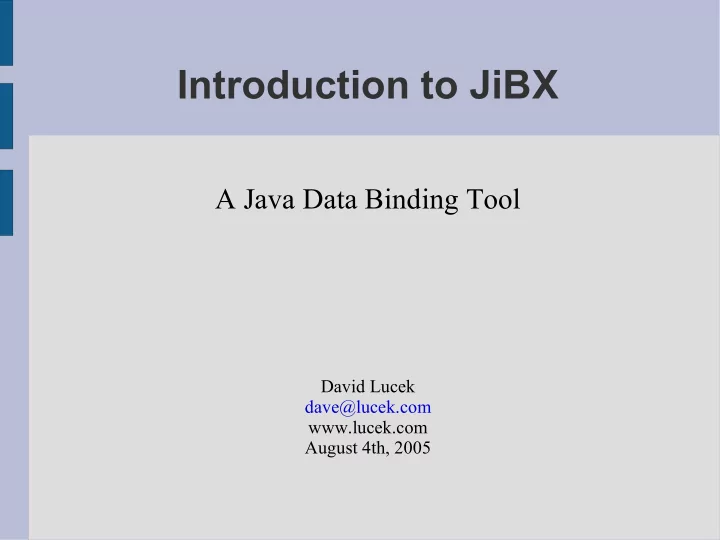

Introduction to JiBX A Java Data Binding Tool David Lucek dave@lucek.com www.lucek.com August 4th, 2005
What is Data Binding ● A Data Binding library converts Java objects to and from XML streams ● Converting to/from XML with existing parsers is time consuming and usually not your core competency ● It allows the application to work with an object model and automatically have XML serialization and deserialization ● Commonly used in SOAP services or any interface that uses XML
Data Binding Definitions ● Marshalling – Serializing Object to a XML stream ● Unmarshaling – De-serializing an XML stream to an object ● Binding – A mechanism to associate objects with XML elements, usually a mapping ● XSD – XML Schema, describes structure of an XML document ● Generator – Takes an XML XSD and create an object model with binding support
Generation Approach to Data Binding ● Use a XSD Generator to create objects then provide either: – Helper classes for each object – Static methods for marshaling/unmarshaling ● One of the first approaches to data binding ● Pros – Easy to create your object model quickly ● Cons – The generated model can be bulky and hard to use. – Forced to use a model possibly not suited to your domain
Mapping Approach to Data Binding ● Use Existing Object Model and mapping mechanism – The mapping mechanism defines the relationships between objects and XML elements. ● Pros – Can work with existing models – Do not have to learn a new model ● Cons – More initial work to create the mappings
Common Data Binding Frameworks ● JAXB 1.0 / JAXB 2.0 – One of the first frameworks from Sun – Uses Generation – Supports almost all XSD syntax – Easiest to get up and running quickly – http://java.sun.com/xml/jaxb ● Castor – One of the first open source frameworks – Uses Generation – Generated model is heavy – http://castor.codehaus.org
Common Data Binding Frameworks ● XMLBeans – Formally from BEA, now Apache – Uses Generation – Becoming more popular – http://xmlbeans.apache.org ● JiBX – http://jibx.sourceforge.net – Uses mapping approach – About 2 years old – Fast
Why JiBX? ● Its fast ● Can your existing object model ● Using generated models is usually painful and forces you to copy to/from your object model ● High degree of control and customization ● Every time the schema changes you need to re-generate, with JiBX just change the map- ping file
Good Features of JiBX ● Almost complete control of translation process – Moving data from attribute to element mappings is trivial ● Custom serialize rs/deserializers ● Custom pre-get and pre-set marshaller/unmarshaler methods ● XSD schema changes => just change the binding file. Very fast for schema updates ● Re-usable abstract bindings ● etc..
Performance of JiBX ● Look at https://bindmark.dev.java.net/ – Compares the different frameworks ● JiBX is fastest or 2 nd fastest for marshaling/unmarshaling among the most common open source frameworks ● Also has small memory foot print ● JiBX uses XML Pull Parser technology with Byte Code generation
Using JiBX ● Download the latest code, 1.0 RC1 ● Put jars into your classpath ● Create mapping – Manually Generate – Or use Xsd2Jibx to generate mapping file from a object hierarchy ● Run classes and binding file through com- piler. Use Ant task ● At run time – Create binding factory and marshaling/unmarshaling context – Marshall/UnMarshal using context
Common Initial Setup ● Use the xsd2Jibx tool to get initial mapping – However, the existing tool is flakey – It does not support xs:unions, xs:any and other XSD syntax – Use it as a starting point ● Manually change/support the mapping file from that point on ● Use Ant task for builds ● There is also an Eclipse plug-in
Common Mapping
Collection Mapping
Structure Mapping 1
Structure Mapping 2
Structure Mapping 3
Abstract Mapping
SOAP Services ● JiBXSoap is a separate project ● Provides a deployable WAR for SOAP services ● Document/Lit Support Only ● Maps Top Level XML element to a method in a handler classs ● Configurable via a descriptor ● Soap Fault handling is a little flaky ● Its a fast and simple architecture ● Example
SOAP Services ● Performs about 2-3 times as as Axis for doc/lit ● Use a simple Servlet for the Soap Protocol handling ● Servlet Container Config <web-app> ● ● <servlet> ● <servlet-name>soap_servlet</servlet-name> ● <servlet-class>org.jibx.soap.server.SOAPServlet</servlet-class> ● <init-param> ● <param-name>quake-service</param-name> ● <param-value>quake-service.xml</param-value> ● </init-param> ● </servlet> ● ● <servlet-mapping> <servlet-name>soap_servlet</servlet-name> ● <url-pattern>/</url-pattern> ● </servlet-mapping> ● ● </web-app> ●
SOAP Services ● Service Configuration <service name="quake"> <schema>SeismicSchema.xsd</schema> <wsdl-uri>http://seismic.sosnoski.com/wsdl</wsdl-uri> <handler- class>com.sosnoski.seismic.jibxsoap.QuakeBase</handler- class> <operation method="process"/> </service>
Demo and Wrap Up ● Demo ● JiBX is great when – You need to use an existing model – Or want to work in a specific model – Need very specific control of the translation process – Need Speed ● When JiBX might not be best – Want to get up and running fast – Not worried about performance
Recommend
More recommend